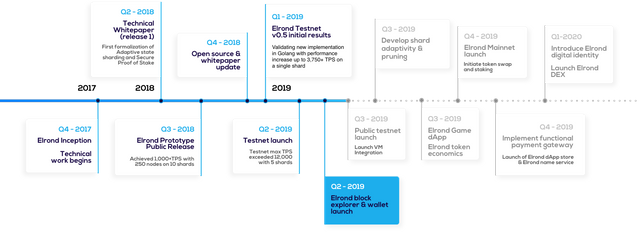Elrond - ROADMAP 2017-2019 - Building the future one step at a time.
Building the future one step at a time.

Q:What is Elrond?
A:Elrond is a complete rethinking of public blockchain infrastructure, specifically designed to be secure, efficient, scalable and interoperable. Elrond’s main contribution rests on two cornerstone building blocks:
- A genuine State Sharding approach: effectively partitioning the chain state into multiple shards, handled in parallel by different participating validators;
- Secure Proof of Stake consensus mechanism: an improved variation of Proof of Stake (PoS) that ensures long term security and distributed fairness, while eliminating the need for energy intensive PoW algorithms.
Q:How does Elrond plan to solve the scalability issue?
A:In Elrond the throughput increases linearly with the number of shards in the network.
Sharding is a scaling technique inspired by traditional concepts of database optimization. Also known as horizontal partitioning, sharding divides the data into several pieces placed on different environments to be processed.
The more validators and shards, the more transactions the network can process. Elrond is performing all network services with minimal energy and computational requirements.
Q:What is Adaptive State Sharding?
A:Sharding is a scaling technique inspired by traditional concepts of database optimization. Also known as horizontal partitioning, sharding divides the data into several pieces placed on different environments to be processed.
In a blockchain context, breaking the network into shards would result in more transactions being processed, verified and validated simultaneously. Each sharding level introduces a certain degree of parallelism, as a result, it becomes possible to process more transactions as the network grows. Implementing any sharding type on a blockchain architecture is extremely difficult.
We can identify 3 sharding types (levels):
- Network Sharding represents the process of grouping the nodes into shards.
- Transaction Sharding takes the complexity to the next level and deals with the distribution of transactions across different shards, but all the nodes keep the entire blockchain into their state.
- State sharding represents the most sophisticated part and is described as a mechanism that allows different shards to deal only with a portion of the state without replicating the data between nodes from different shards. A state sharded blockchain can be seen as a network of fully interconnected blockchains.
In order to match the current scalability needs, Elrond introduces a novel state sharding scheme, called Adaptive State Sharding, with a dynamic model that allows the network to adapt to population and demand changes without compromising security, availability and decentralization.
Q:What is SPoS?
A:In general, Proof of Stake (PoS) concept states that a node’s probability to validate block transactions is proportional to how many tokens it is staking.
Secure Proof of Stake consensus mechanism expands on Algorand’s idea of a random selection mechanism for the validators, differentiating itself through the following aspects:
• Elrond proposes an improvement which reduces the latency allowing each node in the shard to determine the members of the consensus group (block proposer and validators) at the beginning of a round. This is possible because the last block's aggregated signature is used as the randomization factor. In contrast to Algorand’s approach, where the random committee selection can take up to 12 sec, in Elrond the time necessary for random selection of the consensus group is considerably reduced (estimated under 100 ms).
• In addition, Elrond refines its consensus mechanism by adding a additional weight factor called rating. The node’s probability to be selected in the consensus group takes into consideration both stake and rating, promoting meritocracy.
• Elrond uses Bellare and Neven multisignature scheme, which eliminates one communication round in the signing algorithm.
Q:How is Elrond different from other blockchains?
A:• Compared to Ethereum, Elrond eliminates both energy and computational waste from PoW algorithms by implementing a SPoS consensus while using transaction processing parallelism through sharding.
• Compared to Algorand, Elrond doesn’t have a single blockchain, instead it increases transaction’s throughput using sharding. Elrond also improves on Algorand’s idea of random selection by reducing the selection time of the consensus group from max 12 seconds to less than a second, but assumes that the adversaries cannot adapt within a round.
• Compared to Zilliqa, Elrond pushes the limits of sharding by using not only transaction sharding but also state sharding. Elrond completely eliminates the PoW mechanism and uses SPoS for consensus. Both architectures are building their own smart contract engine, but Elrond aims for EVM compliance to to achieve interoperability between blockchains.
Elrond Community Platform: https://community.elrond.com
Twitter: https://twitter.com/elrondnetwork
Official website: www.elrond.com
Elrond Github: https://github.com/ElrondNetwork